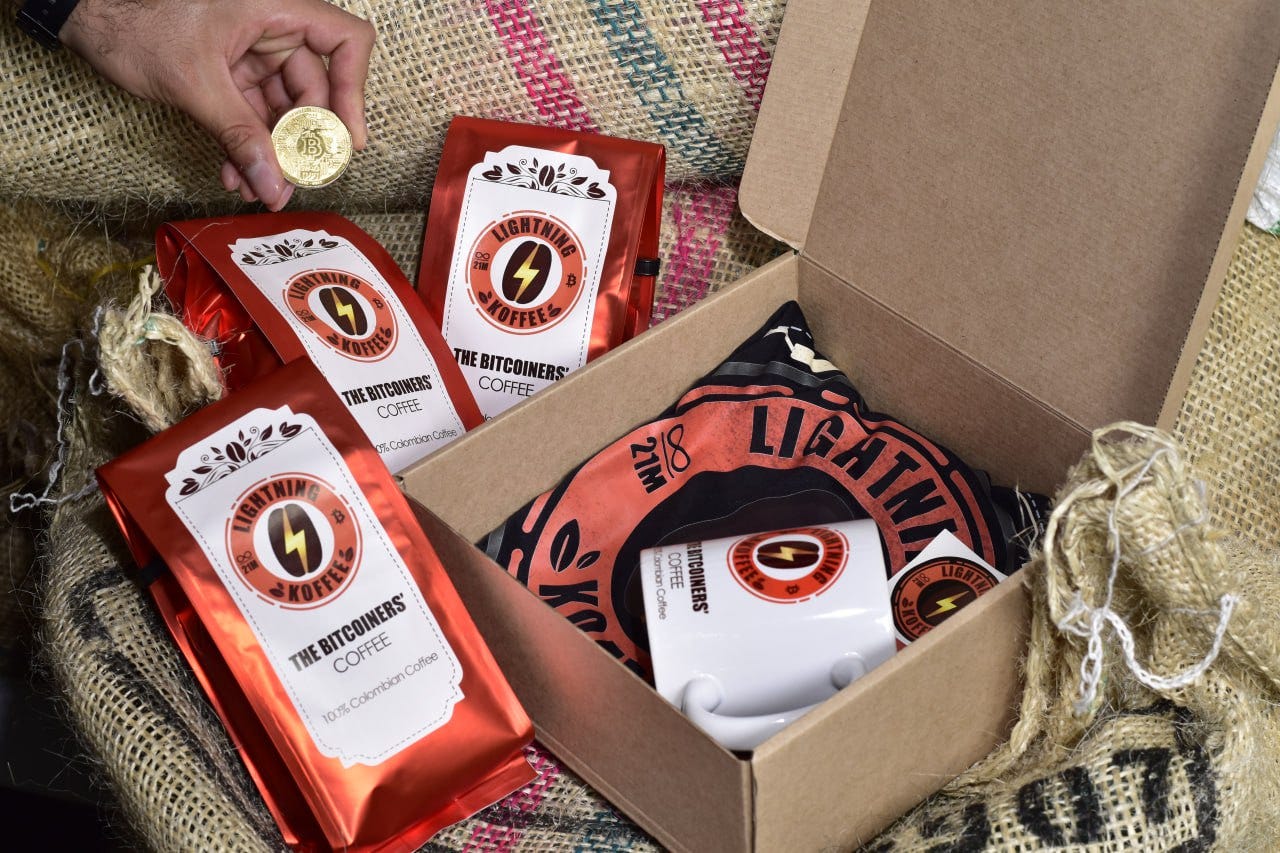The Colombian Man Running A Coffee Business Over the Lightning Network.
How Lightning is powering small businesses.
The Misfit newsletter gives a spotlight to people all over the world using bitcoin to reclaim their financial freedom, improve their communities or businesses, and ultimately, protect their human rights. Join the community of misfits exploring Bitcoin as a tool that helps elevate humanity by subscribing to The Misfit below.

Like millions of people, Jose was laid off from his job at a factory shop in Italy. The COVID-19 pandemic had forced the shutdown of factories around the country. With nothing else to do, he decided to learn about bitcoin from his nephew who was completely absorbed by it – from what it is, where to buy it, and how to keep it safe.
Jose never imagined those innocent lessons would one day turn into him running a coffee business that accepts bitcoin over the Lightning Network.
Jose and His ‘Lightning Koffee’ Business.
Before long, Jose became obsessed with Bitcoin. Bitcoin opened up his understanding of money, commerce, and how the world works. When our understanding expands, it has a way of injecting us with vitality, hope, and enterprise.
Now engrossed by it, Jose wondered: why not merge my passion for Bitcoin and my roots? Why not take Colombia’s artisanal coffee and sell it to bitcoiners to help “propel a bitcoin circular economy?” For bitcoin to reach critical mass, people need to spend it. Not just buy and hold it. Jose knew this and wanted to play a role in helping bitcoin attain success.
It was this simple question that sparked the business idea of “Lightning Koffee” – a small business that sells coffee bags in exchange for bitcoin. Simple yet transformational.
Quick Rundown of The Lightning Koffee Process.
Jose sources artisanal coffee beans from a caficultor (coffee grower) in Santa Barbara, Antioquia which is about 1.5 hours from where he is in Medellín. He says he pays a premium price in order to get the highest quality coffee beans.
When the coffee beans arrive in Medellín it passes through a process called trillar (thresh), which is when the shell of the coffee bean is removed so that the green fruit is left behind. The fruit is then toasted, ground, and packaged. Once ready to sell, Jose will promote the coffee bags on social media and hope to make sales.
Fortunately, his girlfriend is a part of the business too. She takes care of accounting and email communication while Jose handles logistics, production, social media promotion, and communication with customers.
Jose hopes to continue innovating, finding new ways to produce more exotic coffee, wrapped in more luxurious packaging “in honour of the cypherpunks, developers, and builders of Bitcoin.” Given they only launched on October 29, 2022 and are making sales, it’s safe to say he’s on the right path.
Accepting Payments Over the Lightning Network.
The beauty of social media and the Lightning Network is that you can reach and service a global audience. The accessibility of both communications and financial payment systems opens new markets and revenue streams, of which Jose is taking advantage of.
Those interested in buying coffee bags from Jose can direct message him (on Twitter or WhatsApp) to let him know how many bags of coffee they’d like to purchase and ask for its price. If they agree to make the purchase, Jose will send them a Lightning invoice for them to pay.
Let’s say, for example, that I agree to buy two coffee bags from Jose worth $20 or 74,117 satoshis (sats for short, which are fractions of a bitcoin. Keep in mind these are not his real prices).
Jose would open up his Bitcoin/Lightning wallet on his phone to create an invoice – or QR code – of 74,117 satoshis. He would then send me the invoice. I would open up my Lightning wallet and pay his invoice. Like a simple two-step scan-and-pay. And voilà, payment is complete! It would arrive at Jose’s wallet in seconds – regardless of me being in Colombia, Denmark or Vietnam.
**Check out this 22 second-video to see a Lightning payment to Jose in action.
“[Making a Lightning payment] takes two seconds. It’s instantaneous… It’s not less time, because it would be embarrassing.” – Jose.
Once Jose’s Lightning wallet reaches a certain number of bitcoin, he transfers it from the Lightning wallet on his phone to a hardware wallet that is a device not connected to the internet. This helps keep his bitcoin more secure and less prone to hacking and stealing.
**Learn the difference between mobile wallets, hardware wallets, and other types of wallets here. A great source to learn about wallets and get started with them is Ben from BTC Sessions. Check out his YoutTube channel here.
The Challenge of Our Existing Payments Rail for Small Businesses.
For now, Jose does not accept credit card payments. Part of this is due to his views of bitcoin as better, more sound money. It’s money that has scarcity, mathematics and energy as backup, inclusivity, decentralization and censorship-resistant qualities. For him, it’s the best type of money.
The other part is that being a minimal viable business, he does not wish to pay VISA or the Mastercard high fees; which can include interchange fees (paid to card issuer), payment processing fees (paid to facilitate transactions), and assessment fees (paid to credit card networks).
The average credit card processing fees range between 1.5% and 3.5% (source), which can eat into profits making it hard for some merchants with small margins to stay afloat. Plus, they can be increased any time with business, political, or economic pressures and incentives. This can make the existing payment rails costly and not always ideal for small businesses.
Why The Lightning Network Is A Superior Payment Option.
The Lightning Network is superior to traditional payments in two ways – speed and cost – and is built as a payments layer on top of the Bitcoin Network. The Bitcoin Network itself was built to keep the official ledger of transactions and was not really designed as an everyday payment mechanism.
The Lightning Network is an extraordinary innovation that adds a payment layer to Bitcoin similar to how VISA adds a payment layer to your bank account. Transactions over the Lightning Network are instant, virtually free, but still ultimately verified and backed by the underlying Bitcoin Network.
That said, transactions can still take place at the Bitcoin layer. But the speed and cost to send bitcoin is a variable. It can take 10 minutes or 10 hours. It can be cheap or it can be expensive depending on the fees set (the reason for this was to prioritize decentralization, robustness, security, and censorship-resistance of the Bitcoin Network. I’ll leave it at that for now).
Now, the Lightning Network solves for bitcoin’s two variables – speed and cost – helping it become everyday money. It is why small merchants that know about it – like Jose – like to run their businesses over it.
“The Lightning Network is a missile.” – Jose
While the Lightning Network empowers merchants with fast, low-cost, global payment capabilities, there are also second-order effects. It gives merchants full financial sovereignty of their funds and allows them to keep more profits. I can’t help but wonder what this will do to the survival and growth and innovation of small businesses – the lifeline of our economy.
But there are also challenges when it comes to Lightning adoption. They are educational, potentially regulatory, and Lightning-related constraints (on the technical side). Most businesses remain unaware of Lightning, others remain watchful and cautious, while a few embrace it as the future of finance for their businesses.
Either way, Lightning gives merchants a way to transact directly with their users while keeping more of their money. Once more and more merchants learn about the Lightning Network, they may find that it makes economic sense to run their business on it.
**New to Lightning? Check out this video “Non-Technical: Lightning Network Explained“
What’s Coming in the Future for Lightning Koffee?
One day, Jose hopes to open a coffee bar in Colombia where he would serve coffee, alcoholic beverages, and delicious Colombian food. He says this coffee space would hold bitcoin-only meetups. This, he hopes, will teach Colombians about bitcoin, raise donations for Bitcoin projects, and be a refuge for foreign bitcoiners visiting Colombia.
For this dream to happen, he needs to raise about $15,000-20,000 USD, which would cover the cost of the coffee bar, hiring staff, getting equipment, and decorating with bitcoin imagery, among other things. He’s currently working on an e-commerce site that will launch later in the month.
Bitcoiners: In the immediate short-term, he dreams of running his own node which he can’t afford to buy at the moment. If you’d like to help him buy a node, you can donate sats to him here: https://getalby.com/p/josebitcoiner
In speaking with him, it was clear this dream gave him great pride and joy and a raison d’être. It’s exciting to see a young man who’s lived under financial constraint take his destiny in his own hands by starting his own business and ensuring he’s in control of his money.
Jose may just represent the beginning of a new wave of merchants opting to run their business on the Lightning Network. He is playing a part in pushing commerce and community forward. And serves as a reminder that if we want Bitcoin to succeed, adopting Lightning to create circular economies is the key to success.
One day, we may just be talking about how new and weird the Lightning Network was, but how quickly it became one of the best ways to accept payments for businesses.



